How To Draw Fall Leaves Step By Step



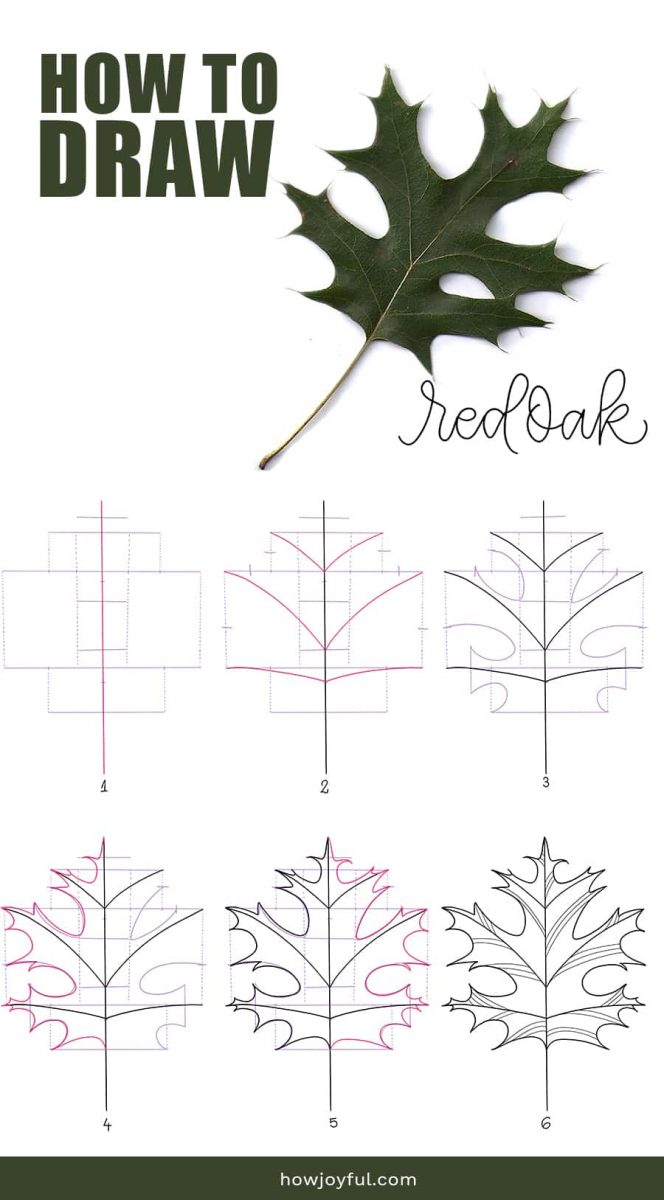





Learn how to draw leaves step past step in this tutorial where we will get from super simple and easy, to cartoon specific leaves past name. We will cover the nuts and parts of a leaf and go into footstep-by-pace doodles from imagination to using a existent foliage found in nature equally a reference for our drawings. And then today you will learn 25+ different leaves for your bullet journal or project.

Learning how to draw leaves is actually simple when you have a pace-by-step tutorial on mitt. It'southward really easier to do information technology this way and not from a video, because you don't have striking the pause push button all the fourth dimension. Everything you need to know is there right in front of you lot.
In this tutorial, we will cover Foliage Drawing 101:
- The basic parts of a foliage
- Step-by-step leafage doodling
- Imaginary leaves vs. realistic leaves
If y'all desire to master how to describe 25+ leaves – whether to decorate your bullet periodical or to illustrate a project – this is the perfect learning forum for you!
Parts of a leafage
While I don't want to make things also complicated when it comes to drawing leaves, I do think that is important to know all the part of a leaf in case you want to get more than detailed and want to make them await every bit realistic as possible.
If yous do want to go the realistic fashion with your colors and details of the drawing, knowing the parts is essential. If you want to create simple drawings or simply very easy doodles, is still good to know some basics of leaves, and then we tin capture the essence of the shape.

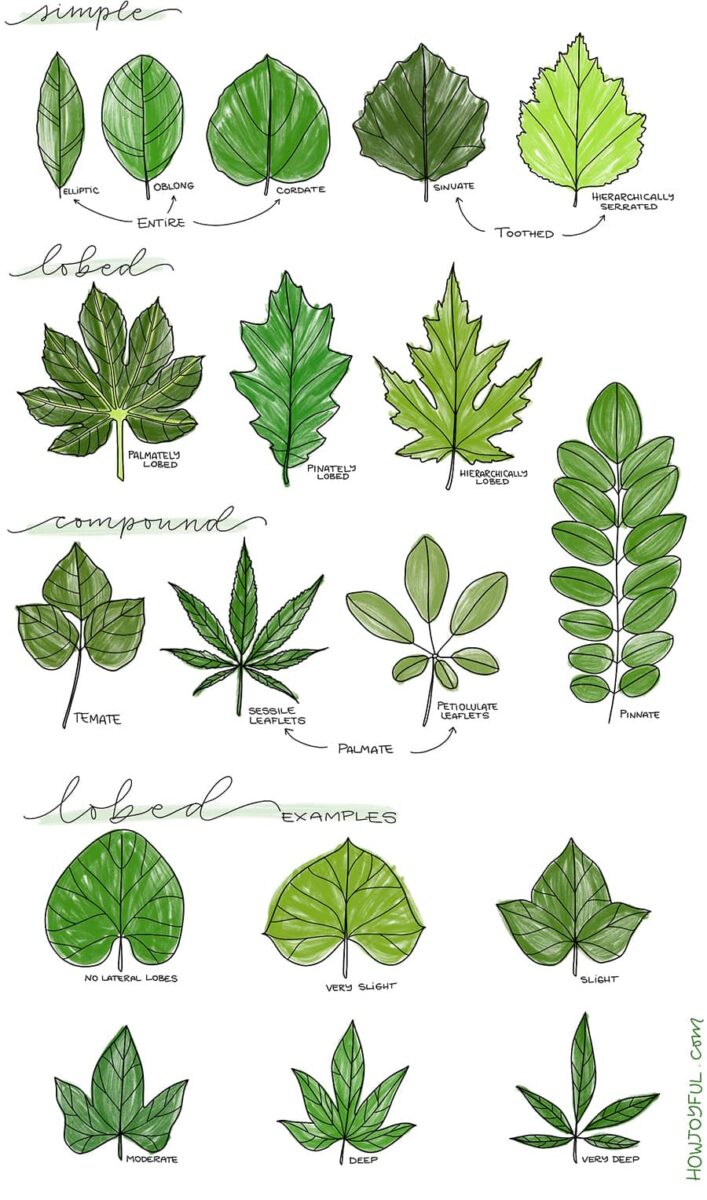
- Stem: A stem is basically the constitute's back up system. The stem is the tiny stick office that connects the leaf to the branch and thereby providing the leafage with a structure to which information technology is attached.
- Axil: The axil is the upper bending between a leafage and the stem to which it is attached. The axil is the part that connects the petiole to the stem. Information technology ever connects at an bending.
- Leaf base: Pretty self-explanatory – the leaf base is the everyman edge of the foliage. Information technology is the lowest part of the leaf connecting to the petiole. Sometimes has similar contours to the cupid'south bow part of a heart shape or an archery bow.
- Petiole: It is the stalk that connects a leaf to the stem of the found or branch.
- Leaf-blade: Too called the lamina (Latin for thin slice/layer/foliage). This role of the leafage needs to be thin and apartment to aid the leaf's aerodynamic properties.
- Leaf lobe: The partially split section/s found in some leaf types. It is distinct from the main part of the leafage with an indentation, called a sinus, and can break the leaf shape all the way to the mid rib, as in the case of very deep lobes. The leaf's continuity of construction can sometimes include serrated (sharpened fasten points) or rounded lobes, with the number of formed lobes varying from two lateral lobes all the way up to countless leaf lobes. The lobes are considered by some artists to be the nigh defining characteristic of a leaf when it is drawn in more detail.
- Vein: Only the same every bit the veins in our bodies, only foliage veins ship essential nutrients and water from the roots to the leaf, and behave away photosynthesized by-products.
- Leaf margin: The foliage'due south outline.
- Venules: These are the smaller veins on a foliage.
- Midrib: The most identifiable function of leaf structure and ofttimes the only part of a foliage we draw when sketching a bones leaf form, the midrib runs from the petiole to the leaf tip. A lot like the foliage's backbone.
- Tip: Nigh leaves have a tip; it's the pointy end of the leaf, like in design to the point of a heart shape. Even if the leafage appears to exist completely round, it will still have a tip.
Drawing supplies
You tin start cartoon and doodling no matter the kind of supplies you have around your house, unlike when we are doing lettering or brush calligraphy, you can beginning with just almost annihilation!
At present, of course, you tin start practicing lettering with any supplies besides, but when you do brush calligraphy you lot need a tool that will allow you to create sparse and thick lines depending on the pressure.
Since when nosotros draw all we need is a monoline pen or pencil (monoline ways the aforementioned thickness no affair the force per unit area or angle we employ) we are good with whatever. Just! Since I loooove office supplies, I practice want to share some of my favorites and some extra tools that would help you lot accept your doodling to the next level!
Oh, also, if you are looking for sketching newspaper, this HP paper rem that I recommend to start using with Castor Calligraphy is also wonderful for doodles, you can too use tracing paper to create "layers" and right your drawings. I as well recommend this journal in case y'all don't accept one, and this notebook in case you want to add watercolor details or you desire to make sure there's no bleeding on your pages since you can color and sketch on both sides of the pages, it's awesome, get it hither!.
If y'all want to work on your iPad instead, here y'all tin can meet a listing of my current digital drawing setup and recommendations. Also, here you tin read all well-nigh the Procreate brushes I use and recommend.
Sketching Tools
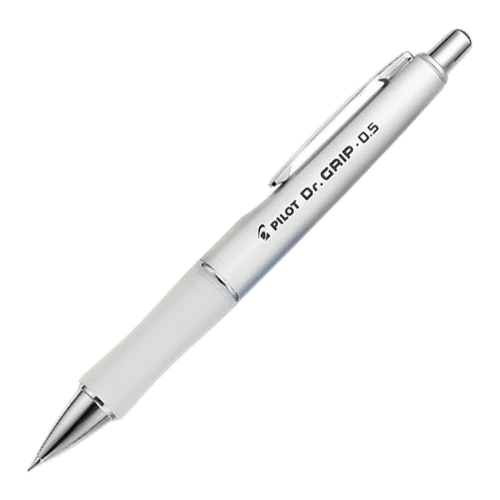
Pilot Dr. Grip Mechanical Pencil
I dear how thick this mechanical pencil is (0.5mm), I always have it in my travel pencil case (if my boys don't steal it). The grip is super comfortable and changing the lead to a softer ane will give you so much command and shades.
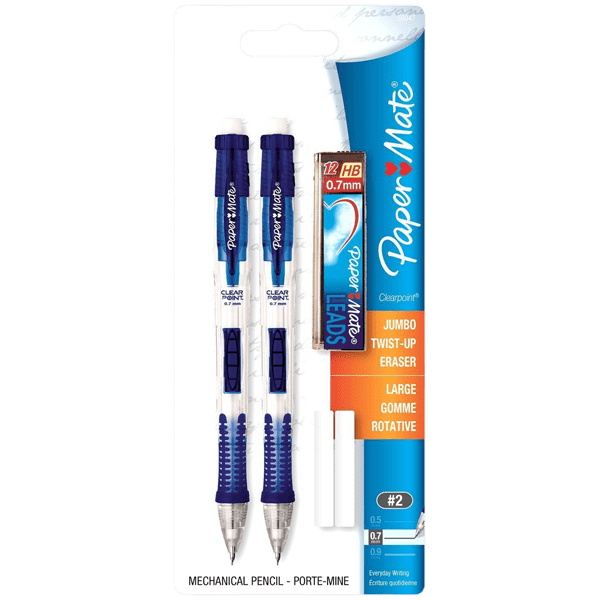
Newspaper Mate Mechanical Pencil Pack
I love having a bunch of these around for when I desire to sketch something really quick, and the 0.seven mm size is my favorite ever! And while they come with HB leads, just similar any other mechanical pencil, yous tin add a different softness of leads. I like to add strikers and I have them in different colors to differentiate the leads.

Pentel Triangle Eraser
This is my accented favorite eraser, I start purchased this one while nonetheless in college dorsum in Chile, it was the older version but the aforementioned concept. I dear that the shape of the eraser gives you three precipitous points that you can use to be more than precise, it's way better than the round ones in my stance. Also, information technology'due south a great alternative if you don't have an eraser shield.

Staedtler Eraser
In that location are some things that once you detect the brand that you love, you lot just stick to it and never wait dorsum. For me the Staedtler erasers are information technology. I've been using them since my early higher years and absolutely love them!
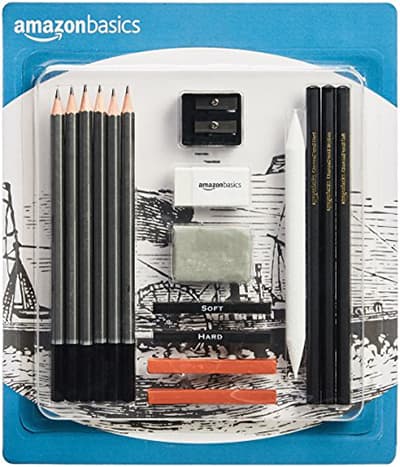
Amazon cartoon pack
If you want to experiment with the unlike softness of pencils, this pack offers 6 dissimilar softness of graphite pencils, three charcoal pencils, 1 sketch stick, 4 charcoal sticks, ane pencil sharpener, 1 charcoal sharpener, 1 kneaded eraser, and 1 white plastic eraser.
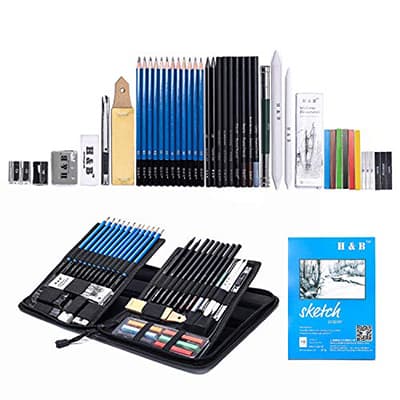
Sketching pack (48 pieces)
If you are looking for an fifty-fifty more complete choice, that is too very budget-friendly, this pack offers pretty much everything you would need (paper included). It even comes with a pouch and then you can deport all your pencils and tools.
Inking Tools

Faber-Castell Pitt Pen gear up
This pack is awesome for lettering because you get a wide variety of thickness and as well ane brush pen, and then if you want to beginning lettering but you lot are not certain if brush calligraphy is for you, you can simply get this and start practicing with the one included hither. They are a not bad deal besides! (Instead of buying them in singles)

Staedtler Lumocolor Fine Point
I dear that this pen can be refilled (the refill station is sold separately) merely if y'all are doing a lot of work, something similar this comes super handy, I was using So MANY pens, until I found this kind of refillable ink pen. They are not as cheap at the beginning simply worth every penny in the long run.

COPIC Multiliner Pack
I was besides introduced to this multi-liners during technical cartoon in college, but it took me a while to notice them here. I dear that these particular ones accept a corking range of thickness, they are refillable and you can also replace the neb. These features are awesome considering I can get through one pen in just a couple of days, so this characteristic really helps my wallet (and can save yous a ton too!)

Tombow Fudenosuke Castor Pen
This brush pen set is by far my favorite when information technology comes to learning, it comes in a soft and difficult version. Fifty-fifty though the difference is not huge, you can make a little scrap thicker downstrokes with the soft tip. They handle pressure amazingly proficient and if you use them with the correct paper (read my paper recommendations ) they can last you a long time. They come in different colors that are vivid and and then pretty.

Pentel Fudenosuke Brush Pen
This one is my 2nd favorite fude brush pen, y'all can also get it in a agglomeration of crawly colors, and that is e'er a plus! (you can see them linked below) I love how durable they are and they have lasted me way longer than I thought they would.
Tracing multiple layers

one – Cricut BrightPad
After using the Cricut BrightPad for a few months I am a converted believer. It's then much better than my older light box (linked below) little things like the fact that yous have to button downwardly in order to change the effulgence prevent y'all from hitting it by accident like I ever do with my older light-box.

2 – Huion LightBox
If yous don't want to use tracing paper a light pad is a perfect solution ( and besides a swell 1 if yous venture into watercolor) This is the one I take now, I tried some of the more expensive ones and this 1 beats most of them, it's worth its weight in gilded (actually way more than it's weight because information technology's super light!)
Looking for more amazing tools for drawing, lettering, and calligraphy? And so you might want to cheque my full guide hither.
How to putter leaves
Earlier getting into very specific leaves and how to draw them. I wanted to share some basic ways we can create variations when we are drawing leaves. These are the basics we should keep in mind when we are doodling leaves and don't desire all of them to look the aforementioned.
I will also cover the easiest way to add dimension and perspective to your leaf. These doodles are non just fun and like shooting fish in a barrel, but they are the perfect filler for when we create Bullet Periodical spreads, to accompany our flower drawings, or embellish our lettering and calligraphy pieces.
The basic shape

- Step 1: Start by drawing a straight line, this will exist the midrib of the leaf.
- Pace two: leaving a small piece at the bottom to serve equally the petiole, outset with a round shape, and straighten your stoke until y'all reach the tip of the leaf.
- Step 3: for the other side, unless you desire to show a side view, mirror the line you created on the first side.
- Yay! Congratulations! You only doodled your starting time foliage!.
Veining variations
Variations on the fashion nosotros describe the veins of a leaf will give u.s. completely unlike looks and can make them feel super different even though they have the exact aforementioned shape.
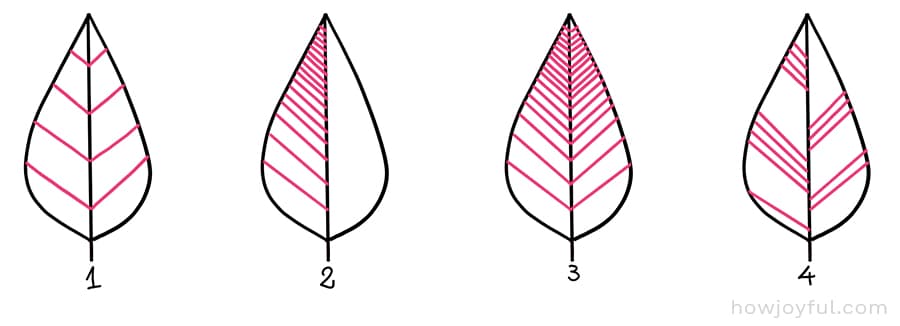
- Variation 1: This option shows equal separations in between the veins. It's the about bones and uncomplicated way to vein a leafage.
- Variation 2: In this instance, I started adding veins with an average separation, and kept adding them closer and closer together as I went forth.
- Variation 3: This variation shows the verbal aforementioned veining I did in variation 2, just this time on both sides. Adding veining to only one side is a smashing way to make leaves different from each other while not making them too decorated.
- Variation iv: Adding an uneven number of lines in scattered places on the leaf is 1 of my favorite means to draw leaves. I started cartoon them similar this when I was little and I judge it stuck since then, so if you have seen some of the floral patterns, you have probably seen this variation.
Angle variation
A great way to not simply add together variations to your leaves but also give more perspective to your drawing is to use angles or slant when cartoon the stem.

- Step one: Outset with a slanted semi/curved stalk, as curved as you desire!
- Step 2: Make your showtime side starting with a curve, straighten information technology as you get all the way to the tip of the leafage.
- Step 3: Instead of only mirroring the other side, try to make it a little smaller, this will give perspective and dimension to your leaf.
- All done! Look how pretty your leaf turned out!
Leafage shape variation

- Variation i: This is a small variation on the bones shape, just by making the leaf base a little wider, we get a completely different look.
- Variation ii: This is the contrary to the beginning variation, instead of making it wider, I keep about of the shape of the leafage the same size, this makes it look more than oval than pointy, information technology's a perfect soft foliage for your drawings.
- Variation 3: Now I tried to make the leaf look more like an egg shape, with a more flat base. This nigh makes information technology look like a eucalyptus foliage.
- Variation 4: Once you experiment with the different shapes that y'all can get with an even line, it's time to spice things up and try completely uneven lines. I actually like to effort and not mirror one side exactly afterwards the other, because just similar our bodies, leaves are non 100% symmetrical, and I think that showing that they are not, gives them a more than natural look.
Doodle leaf examples
Now that we know the chief ways that we tin create variations in our leaves, allow me show yous some examples of my favorite (imaginary) leaves. I say imaginary considering the whole signal of doodling leaves at this betoken is to experiment with the shapes and non restrict yourself trying to re-create shapes that are established in accurate botanical leaves.
How to doodle leaves
1. Brainstorm by drawing a straight vertical line. This will become the leaf midrib.
2. Remember to exit a small section at the bottom of the leaf; this will exist the petiole. It might aid to turn your drawing book horizontal for this next scrap; outset as though you are nigh to draw a pocket-size hill; round the top off so taper and straighten the stroke to the terminate of the line to create the leafage tip. When y'all tilt the midrib line sideways, information technology volition look as though a small lopsided hill is ascension from it.
3. Create a mirror image of stroke on the other side of the midrib or y'all can keep the foliage at the Pace ii stage if yous desire to describe the leaf in profile.
Yay! Congratulations – you have just doodled your offset leaf = )
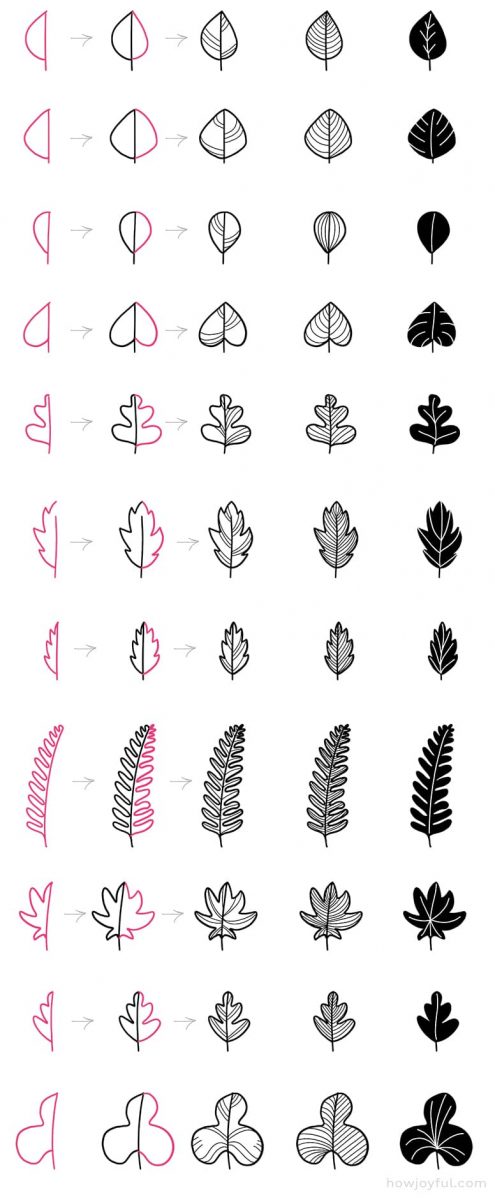
How to draw a simple leaf
Now that we know how to doodle very unproblematic leaves, we are going to pace information technology up a chip and really look at nature to depict our leaves, I like doing this when I work on botanical line drawing of flowers and other elements because to me there is no more cute reference than looking at what mother nature has created.
But because we still want to brand them simple, I will be modifying the final shape a petty. So nosotros volition non go into the details and finishing that make them wait more realistic.
The process will be that I volition evidence you a picture of the foliage we are going to draw and and then I volition evidence the steps nosotros will accept to accomplish something as close as possible to the shape of the original leaf, but SIMPLIFIED and so it's not too hard for beginners.
Drawing a Ginkgo leaf
Allow's kickoff with a somewhat anarchistic leaf, the ginkgo leaf. This is a fan-shaped leaf that sometimes has a divers middle division, sometimes, like in the sample above, it looks similar one unmarried fan with veins radiating out into the leaf blade.

- Pace 1: To start with the guidelines for this foliage, draw a straight vertical line and mark a piddling above half-point, make another point halfway in the height space. And then describe a horizontal line a little bigger than the half-point we already dew. Outset a semicircle from one betoken to the contrary 1.
- Step 2: Sketch on top of the bottom stalk of our guidelines and make a rugged edge on the meridian, right on the heart go in halfway, and proceed mirroring the previous side.

- Step 3: To finish it upwardly, add smaller lines around the edge pointing inwards, and from the center to the outside of the leaf.
Drawing a Cerise Maple leaf
The leaves of the ruby-red maple are lobed with 3 to five lobes depending on the age of the leaf. The leaves are green in summer and yellow/reddish during the fall. The margin of the leafage is serrated.

- Pace i: Draw an elongated vertical line with a shorter horizontal line transecting it a trivial less than midway from the top. Add the connecting petiole/leaf base line a curt manner into the vertical line. Just under the horizontal line, demarcate a dotted line to use as an anchor.
- Pace two: Describe 2 connecting lines, from the right and left sides of the horizontal line to join with the petiole/leafage base line. You lot will now have a facsimile of an upside-down triangular shape with slightly curved sides.

- Footstep 3: Using the dotted line for an anchor, connect it to the leaf tip, creating a slightly curved-sided triangle. Using the upside-down triangle as a base, draw 2 sweeping curved lines to the foliage base.
- Step four: Using the leaf framework you have created, begin serrating the right side of the leaf margin, from the tip to the base. Duplicate serration on the left side of the leaf.

- Pace 5: Remove your ballast guidelines with an eraser.
- Step 6: Add custom venule texture and color if yous similar.
Cartoon an Ivy foliage

Most leaves are dull light-green, lobed, with singled-out light veins. Mature leaves are sleeky greenish and unlobed. The size, shape, and color of the leaves depend on the variety of the ivy plant.

- Step 1: Offset with your standard vertical and horizontal lines with indented markings a short way in from the ends; add demarcated dotted lines ane third and two thirds along the vertical line.
- Step 2: From the ends of the horizontal line, depict connecting lines to the lesser marker, thus creating a flattened triangle shape.

- Step 3: From the leaf tip, draw a descending line connecting to the right horizontal side, remembering to indent the line according to leafage blazon. Information technology will resemble a stock market chart if the shares are tanking! Next, conduct the line through to the bottom marker in a long sweeping curve, using the dotted line as a guide for when to begin curving the line dorsum in toward the leaf base.
- Step four: Indistinguishable the lines you have created on the other side and erase all the guidelines y'all don't need anymore.

- Step 5: Create the main vein lines, correct side first, and so duplicating them on the left side.
- Stride half dozen: Yous can either color the leaf equally it is or add highlights and textures by drawing venules in patterns.
Cartoon a Sugar Maple leaf
Both the carbohydrate maple and the Norway maple are large, 5-lobed leaves, with the sugar maple leaf having a few large teeth and rounded spaces. Green during the summer, turning golden reddish in the fall.

- Stride 1: Draw out the standard vertical line, but this time section it into 5 horizontal lines, with 4 guidelines and 1 leaf base of operations line. Next, create construction anchors with dotted lines, equally shown.
- Step two: Using the foliage base guideline as an anchor, draw two curved, branching lines at the bottom and 2 arching lines upwards to the horizontal line at the top.

- Step 3: Create the structure for the leaf lobes by crossing the top diagonally branching lines with an 'x'.
- Pace 4: Remember those 'join the dots' puzzles kids like to draw? Now it's time for you to connect the dots, but this fourth dimension yous'll be creating the leaf margin on the right side past cartoon sweeping lines from the leafage tip to the leafage base, moving from betoken to point.

- Step five: Repeat 'joining the dots' on the left side to complete the leafage margin.
- Footstep 6: Remove lines you no longer need and color or add venules for texture.
Drawing a Red Oak leaf
The cherry oak leaves take indicate edges, if you are interested in learning more near oaks and how to differentiate them, the Forest Service has this keen Field Guide to Native Oaks.

- Step 1: Using a vertical line as your basic leaf structure, demarcate information technology into horizontal sections as above. Once you have the horizontal lines in place, add your dotted anchor guidelines.
- Step 2: Add short lines to denote the points where the red oak leaf'south lovely serration and curves are indicated. Adjacent, add together the 'branch' veins, slightly curving out to the corner points of the dotted anchor lines.

- Step 3: This is the fun part; begin adding the anchor curves. They will look exactly similar lobes, sweeping 'u' shapes flowing from bespeak to betoken.
- Footstep 4: A bit more intricate, just still fun; join the sweeping lobe 'u' shapes past adding more curves. First do one side, and then indistinguishable information technology on the other.

- Step 5: Remove the guidelines yous don't demand.
- Pace 6: Add texture venules or colour to your liking. The structure of the red oak leaf may exist a picayune challenging at first, merely the beautifully serrated lobes are well worth the effort.
Drawing a Silver Maple leafage
The silver maple leaves are 5-lobed more than than halfway to the midrib. Margins are irregularly double-toothed. The leaf surfaces are low-cal green above and white to silvery below, giving it the common name "silverish maple." Fall coloring is calorie-free dark-green to yellow-brown.

- Stride 1: Now that have mastered the complexities of the serrated, multiple lobes of the oak, its time to revisit the maple foliage. Beginning with the vertical line, add iv anchor lines at horizontal points. Then information technology's time to add together the dotted guidelines for the structure. Yous can use a ruler or other straight edge drawing tool to do this or try freestyling it.
- Footstep 2: Side by side, bring together the summit horizontal line to the guideline denoting where the foliage connects to the petiole, and so using sweeping downward lines, creating an upside-down triangle.

- Step 3: You lot might demand to continue an eye on the illustration here. Create the foliage tip by drawing an upside-downward v-shape with slightly curved sides. Side by side, add a truncated upside-downwardly 5-shape from the top horizontal line to the middle. Depict two sweeping arcs on each side, under the upside-down triangle.
- Step 4: It'southward 'join the dots' fourth dimension. Create the serrations by post-obit your guidelines in the leaf shape shown above.

- Step 5: Farther enhance the serration past creating more detail along the leaf margin. Remove anchor lines.
- Pace vi: Colour your leaf as you like, co-ordinate to season.
Drawing a Bur Oak leaf
The bur oak leaves are roughly obovate in shape, with many lobes, about 6 to 12 inches long. The two middle sinuses nearly reach the midrib dividing foliage most in one-half. The lobes near the tip resemble a crown, in the summertime they are green to a higher place and paler, fuzzy below.

- Stride 1: The very definition of a lobed leaf, the bur oak is a fine case of softly rounded lobes and sinuses. Commencement, draw your vertical line and add the demarcated horizontal anchor points (there are 9!).
- Step 2: From the vertical line, add the branched vein structures, curving them in sweeping lines outwards. Create dotted guidelines.

- Pace three: Add together more than outward sweeping co-operative lines, making the leaf skeleton look similar an elaborate candelabrum.
- Step 4: Create flowing lobe lines from the leaf tip to the leaf base, using the dotted lines and branch lines equally a guide, remembering to taper information technology into the iconic bur oak obovate shape.

- Step 5: Duplicate the flowing, sweeping curved leafage margin on the other side.
- Step vi: Remove the guidelines and add color or venule texture lines every bit yous like.
Drawing an Ash leaf
Ash leaves are compound, 8 to 12 inches long, 5 to 9 leaflets/foliage. Leaves may be finely toothed or have smooth edges. Branches and buds are opposite with a single bud at the cease of the branch.

- Footstep 1: This classic compound leaf shape is easier to depict than information technology looks. It'south actually a drove of basic leaf shapes on one long stalk. The only challenge is to maintain the leaf's beautiful symmetry. Brainstorm by drawing your standard vertical line and adding 3 horizontal anchor points. Draw a circle around the meridian horizontal anchor signal. You can do this freestyle, or use a compass drawing tool.
- Step ii: Adjacent, create a vertical curved line, from the leaf tip, encompassing the arc of the tiptop circle, and joining the vertical line at the base of the circle.
- Step 3: Duplicate on the other side.
- Step 4: Add 2 sets of upward branching diagonal lines, starting under the leaf yous created in Steps 1 – 3, and moving downwards.
- Step 5: At the lower third section of the branches, describe one circle on each branch, freehand or using a compass drawing tool. I propose that if you are drawing a large size foliage, to utilize a drawing tool until y'all have more feel with circles.
- Step six: Create the base line of the leaf by drawing a curve from the first foliage tier tips to the main vertical line.
- Stride seven: Repeat this on the second leaf tier.
- Step 8: Add the summit line of the leafage tiers past drawing a curved line from the leaf tip to the base of operations of the vertical line.
- Pace ix: Erase guidelines, remembering to keep the leaf vein lines. Add color or leaf venule texture every bit you lot like.
Drawing additional leaves

Now that we have a better agreement of how many of the leaves found in nature can be used as inspiration for our simple drawing of leaves, I wanted to show a batch I drew inspired by the image above, they are a mix of reference and but imagination. Sometimes that's the virtually interesting office of drawing them, the fact that we are making them then unique to our style.

Using your leaves, more than posts for you!
I hope you lot enjoyed this post and come back presently for more than drawing and doodling tutorials. Have a wonderful day!
Doodle abroad!
Source: https://www.howjoyful.com/drawing-leaves/
Posted by: westfalltherwer.blogspot.com


0 Response to "How To Draw Fall Leaves Step By Step"
Post a Comment